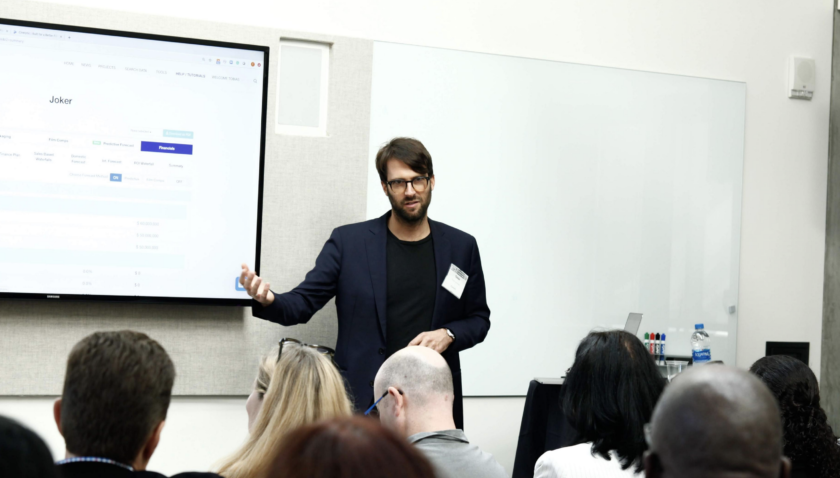HITS

HITS Fall: AI-Based Analytics Can Give Content Owners Productivity Boost, Cinelytic Says
Story Highlights
Content owners today are looking for every edge they can find to improve productivity, and real-time analytics driven by artificial intelligence (AI) made available in a cloud-based project management system can accomplish that, according to Tobias Queisser, CEO and co-founder of Cinelytic.
When the startup was created four years ago, its aim was to bring best practices from fields including finance and science to build a platform that would help entertainment companies “make faster, smart decisions,” he said Oct. 3 during a breakout presentation called “Real-Time Insights at Your Fingertips: A Better Way to Assess Content Value” at the HITS Fall event.
The company realized that what could achieve that would be AI and machine learning (ML)-powered real-time data and analytics that provided insights to the content owners that they could use in their day-to-day businesses, he recalled.
Pointing to the film industry in particular, he noted there’s been a “drastic change,” with revenue from home entertainment declining, especially from physical media, while streaming has become the main source of revenue in the U.S.
There’s basically two separate U.S. film industry sectors now, he noted: A theatrical one in which the major Hollywood studios and “mini majors” owned 91% of the market last year, according to Comscore; and a streaming one in which Amazon and Netflix combined accounted for 75% of U.S. subscription video on demand viewing in the U.S. in 2018, according to eMarketer data. However, the control we’ve seen of the streaming market by tech companies “will change probably soon,” he predicted.
Those two landscapes have led to “information asymmetries” and current business methods haven’t kept pace with technology, he noted. For one thing, there’s “very inefficient workflow,” with too much reliance on email documents and paper printouts, data that’s not readily available because it’s often “siloed in different departments,” slow decision-making, static query-based forecasting and a lack of audience understanding, he told attendees.
Incentives along the value chain haven’t been aligned and each link in the chain often operates in its own silo, creating inefficiencies by those working within the organization’s divisions not communicating with each other and not operating on the same level of information, according to the company. In packaging, content strategy decisions are impeded by limited data insights.
With the financial folks involved in greenlighting projects, it’s often difficult to assess project value with narrow understanding of the best path to market. Production budgets, meanwhile, are often disconnected from the addressable market size. When it comes to marketing and distribution, audience targeting starts too late in the process. And when it comes to exhibition, consumer metrics are often siloed at the last step of the value chain, according to Cinelytic.
“A lot of these processes are very siloed,” so what Cinelytic wanted to do was create “one system that basically helps to ally all of these different parts of the value chain,” Queisser explained.
What it developed was an easy-to-use, cloud-based, multi-user platform with first-rate data, predictive analytics and sophisticated financial modeling tools, he said. Its key features include a central project management system, ML-based revenue prediction by territory, an advanced talent and film search engine, data and analytics-driven tools, financial and scenario development tools and the ability to collaborate across teams, according to Cinelytic.
The company uses neural networks — different combinations of ML – that “replicates brain functions in an organized way” and, after collecting a lot of data, the system automatically recognizes patterns and creates a forecast in real time that can predict whatever the user wants it to predict, Queisser explained. The company’s implementation of state-of-the-art ML allows users to predict revenue and ROI for films during development to inform greenlighting decisions, according to Cinelytic.
Its integrated talent analytics tools, meanwhile, help identify key talent and provide data-driven insights to evaluate directors, actors, writers and producers, Queisser said.
Cinelytic’s data and analytics tools can be used to asses all aspects of a project for faster and smarter decisions regarding what films to produce and how, he noted, adding the data collected includes piracy-related info. The company collects 100 million daily piracy views globally, he told attendees.
The company’s sophisticated ML-based predictive forecasting tool is, meanwhile, seamlessly integrated into its detailed financials models, according to Cinelytic.
The company says it’s also partnered with leading data providers to provide the best and most comprehensive data possible.
HITS Fall was presented by Entertainment Partners, with sponsorship by Genpact, VBI, edgescan, LiveTiles, MarkLogic, EIDR, Signiant, Cinelytic, Microsoft Azure, Richey May Technology Solutions and Comcast Technology Solutions.
The event was produced by the Media & Entertainment Services Alliance (MESA) and the Hollywood IT Society (HITS), in association with Women in Technology: Hollywood (WiTH); the Content Delivery & Security Association (CDSA); and the Smart Content Council.
Click here to download audio of the presentation. Click here to download the presentation slide deck.









